TikTok has grown in popularity in the last several years, with over 1.677 billion users on the platform as of August 2023. On top of this, 1.1 billion of these users are active monthly users, and the platform is predicted to reach approximately 2.25 billion users by 2027. So, if you’re creating an online advertising strategy in 2023, you’d need to pay attention to TikTok.
If you’re new to TikTok, check out our guide on creating a successful TikTok marketing strategy because this article looks explicitly at paid ads. According to TikTok, users are 1.5 times more likely to purchase products after seeing them advertised on TikTok, so it’s definitely a platform that is worth the investment.
Read on for a guide that will help you stand out on TikTok and ensure you get the most out of what the platform has to offer!
Table of Contents
What are TikTok ads
Types of TikTok ads
Promoted TikTok videos vs. TikTok ad campaign
Which brands should use TikTok advertising?
How to set up ads on TikTok: A step-by-step guide
TikTok advertising best practices
TikTok ads FAQs
Start advertising with TikTok
What are TikTok ads
TikTok ads are a form of paid advertising on the popular social media platform. These ads allow businesses to promote their products, services, or brand to TikTok’s vast and engaged user base. TikTok offers various ad formats and features to help businesses reach their target audiences.
Types of TikTok ads
There are many different types of TikTok Ads that a business can use. Let’s look at the top types of ads:
- In-Feed ads (formerly known as “Native Ads”): In-Feed Ads are short video ads that appear in users’ “For You Page” (FYP) feed as they scroll through the TikTok app. These ads typically last between 9 to 15 seconds and can include a clickable call-to-action (CTA) button that leads users to a specific landing page or app.
- TopView ads: TopView ads are similar to In-Feed ads but with a critical difference. When users open the TikTok app, the first thing they see is a TopView ad, which is a full-screen video that plays automatically. These ads have high visibility and can make a strong initial impression.
- Branded effects and filters: Brands can create augmented reality (AR) effects and filters that users can apply to their videos. When users interact with these effects, they engage with the brand’s content. This type of ad is often more interactive and immersive.
- Branded hashtag challenges: This ad format encourages user participation. Brands create unique hashtags and challenge users to create content using them. This content can include user-generated videos related to the brand or product. Branded Hashtag Challenges often appear on TikTok’s Discover page, where users can easily find and engage with them.
- Branded content: Brands can collaborate with TikTok influencers to create promotional content. Influencers share videos that feature the brand or product in a natural and authentic way. This approach can help reach the influencer’s engaged audience.
Promoted TikTok videos vs. TikTok ad campaign
Promoted TikTok videos and a TikTok ad campaign represent distinct approaches to advertising on the platform. Promoted TikTok videos involve promoting a single video to a broader audience, offering a simpler and more singular method to enhance the visibility of a particular piece of content. They’re used when you have a specific video you wish to share with a broader audience without the complexities of a full-scale ad campaign. However, it typically offers fewer customization options than a comprehensive campaign and is well-suited for one-time promotions.
On the other hand, a TikTok ad campaign involves a more comprehensive advertising strategy. It encompasses multiple ad formats, targeting options, budget allocation, and campaign objectives. This approach provides more customization, allowing businesses to tailor their advertising efforts to specific audiences, scheduling preferences, and budget constraints. It also involves diligent campaign management, which allows for continuous monitoring, adjustments, and A/B testing to optimize ad performance over time.
The choice between a promoted video and a TikTok ad campaign hinges on your specific marketing goals, budget, and the level of customization and control required for your TikTok advertising strategy.
Which brands should use TikTok advertising?
Many brands use TikTok for advertising, but one thing they tend to have in common is that their products naturally fit with the video format of TikTok. Generally, TikTok is better suited for B2C brands that can show their products in video content, whereas B2B brands that sell difficult-to-illustrate products or services may be more challenging.
However, challenging does not mean impossible. Several B2B businesses, like Adobe, are thriving on TikTok and creating empowering content that connects with their audience.
Here are some categories of brands that can benefit from using TikTok ads:
- Fashion and beauty brands: TikTok’s visual and creative nature makes it an ideal platform for fashion and beauty brands to showcase new collections, makeup tutorials, and style inspiration.
- Food and beverage brands: Restaurants, food delivery services, and food and beverage brands can use TikTok to showcase their offerings, share recipes, and engage with food enthusiasts.
- Fitness and wellness: Fitness trainers, wellness coaches, and health brands can use TikTok to share workout routines, nutrition tips, and motivational content.
- Tech and gadgets: Brands selling tech products and gadgets can create visually appealing and informative videos to showcase their products’ features and benefits.
Ultimately, the effectiveness of TikTok ads depends on the brand’s creativity, understanding of its target audience, and the ability to create engaging content that aligns with the platform’s culture.
How to set up ads on TikTok: A step-by-step guide

Now that you know what type of ads you might like to run for your business, let’s look at how to set up ads.
If you don’t already have a TikTok account, you should start there. But, before you start running ads on TikTok, you want to have a basic TikTok strategy and an in-depth understanding of the type of content you want to share.
Here is a step-by-step guide for setting up ads on TikTok:
#1 – Create a TikTok ad account
Visit TikTok’s advertising platform at ads.tiktok.com and follow the prompts to set up your business account. Make sure to complete your profile with relevant information.
#2 – Create a new campaign
Find Campaign on the top menu in TikTok Ads Manager, and click Create.
Note that you will be prompted to choose Simplified Mode or Custom Mode. You may want to start with Simplified Mode, but as you run more TikTok ads, you can switch to Custom Mode to set more complex configurations.
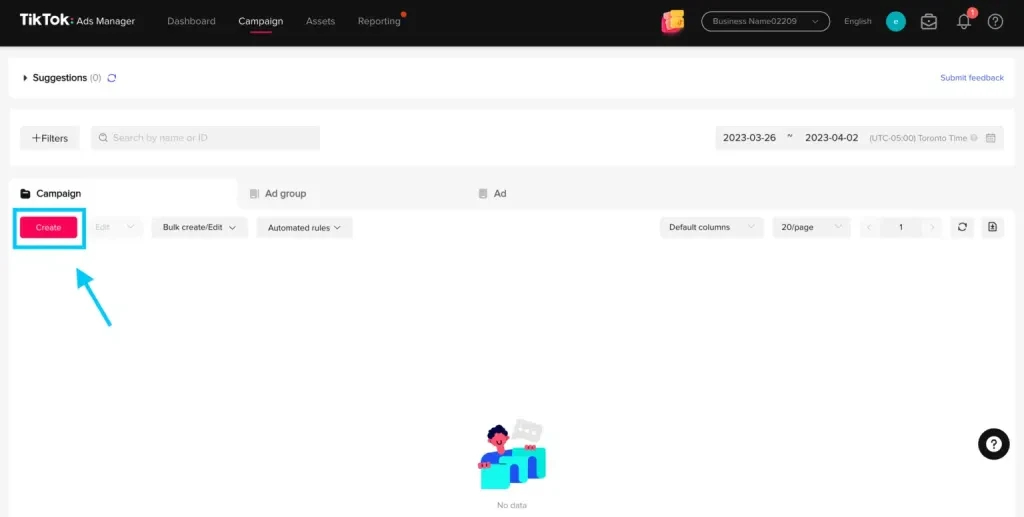
The next few steps will focus on configuring the ad in Simplified Mode.
#3 – Set your advertising goal
TikTok offers various objectives: traffic, community interaction, lead generation, and website conversions.
What do these mean, and which should you choose?
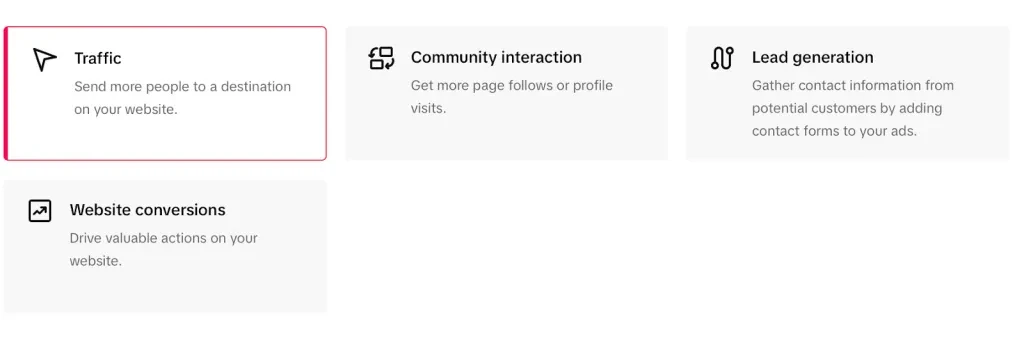
TikTok defines these objectives as follows:
- Traffic: Send more people to a destination on your website.
- Community interaction: get more page follows or profile visits.
- Lead generation: Gather contact information from potential customers by adding contact forms to your ads.
- Website conversions: drive valuable actions on your website.
The objective you select should align with your specific marketing goals. Consider your target audience, the actions you want them to take, and where they are along the sales funnel. For example, if you want to target people already aware of your brand, you likely want to focus on website conversions.
Note: if none of these advertising goals fit your marketing strategy, try custom mode as more options exist.
#4 – Select your audience
Next, you will be prompted to select your audience. You can choose the Automatic Audience option, which will allow TikTok to find the most receptive audience for your business. In this case, the only factor you can change is location.
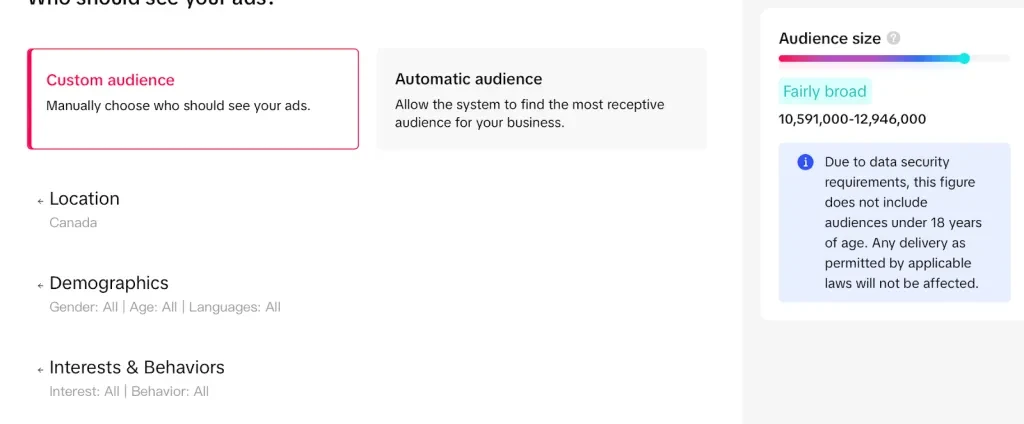
We recommend customizing your audience so your ads get in front of the right people. You can customize your target audience by gender, age group, language(s), and location. Note: as you make selections, the slider in the top right corner of this page will let you know the audience size. This is helpful to ensure you don’t target too small of a group.
You can focus the target audience even further through interests. For example, if you are a skincare business, you can target “beauty” as an interest.
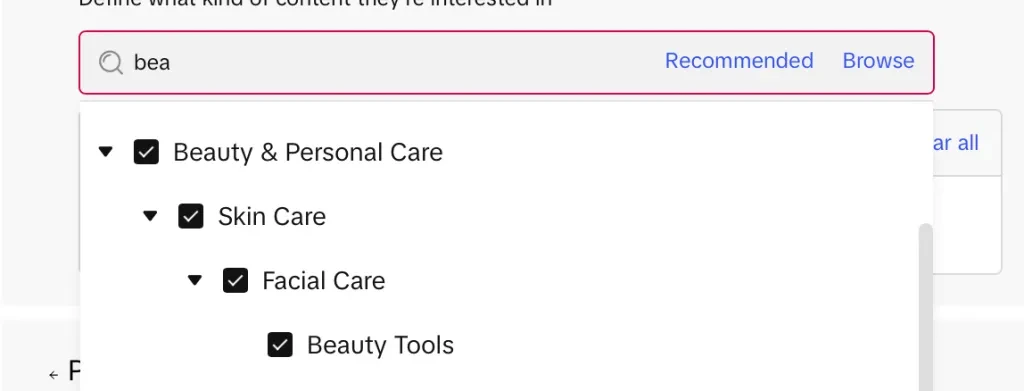
Finally, you can also target users who interact with TikTok content to increase the likelihood of the ad reaching people who are likely to engage with the content.
#5 – Set a budget
Next, you will be prompted to set a budget for the ad and an end date. You can select a daily budget (minimum US$ 5) or a lifetime budget (US$ 70). If you set a daily budget, you can run the ad with no end date and then choose to end it when you feel it has done its job.
#6 – Create a new ad
Now you’re ready to create your ad, and this is the fun part. But there are also two options: using an existing video or uploading a new one. If you create an ad with an existing video, note that you cannot change the original caption but can add a specific call to action.
If creating a new video, ensure it follows TikTok ad specs.
Be aware that once you submit your ad, it will go through a review process before your audience can view it.
#7 – Measure performance
Once the ad is live, measuring its performance is essential. Use TikTok analytics to determine how the ad is doing regarding impressions, clicks, conversion, etc. Make adjustments as necessary, such as modifying targeting parameters, increasing or decreasing budget, and optimizing ad content.
In TikTok’s Ads Manager under analytics, you can view specific video insights, audience insights as well as attribution analytics and you can create custom reports to gain a more in depth understanding of how ads are performing. Additionally, in the creative inspirations section of the analytics you can see the current top performing ads and what is currently trending on TikTok.
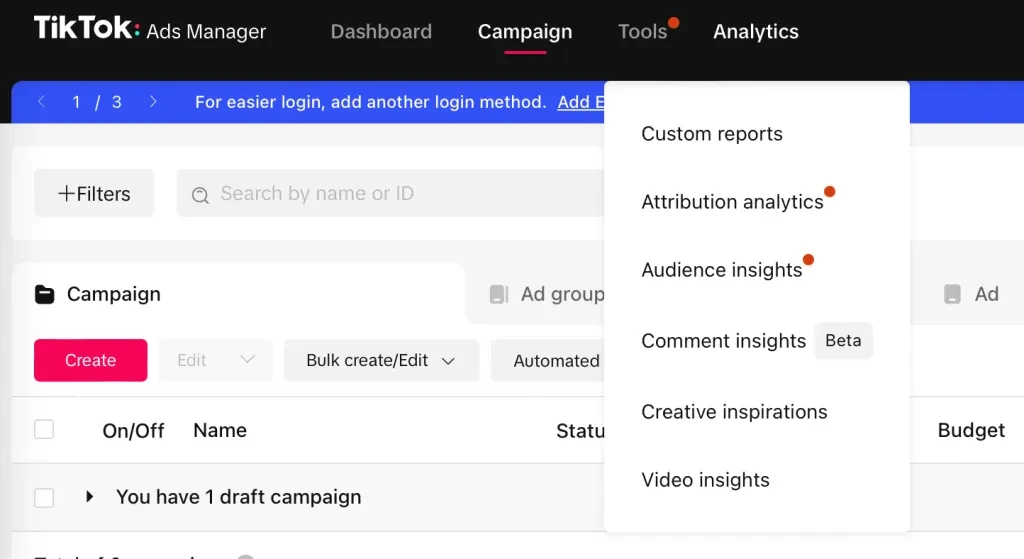
TikTok advertising best practices
It may seem overwhelming to figure out the best way of approaching TikTok ads, especially since ads can be promoted videos and there is such a wide variety of content on TikTok. So, here are some important things to consider when creating TikTok ads to keep you on track and to ensure success.
- Remember, follower count isn’t everything. Authentic content that speaks directly to your audience can still succeed on smaller accounts or for businesses just starting their TikTok journey.
- Capture the attention of the audience in the first 3 seconds.
- Put critical information in the middle of the screen.
- Localize your ad’s language.
- Ensure your content is accessible, for example, just captions.
- Use TikTok’s Creative Centre for inspiration and discovering trends.
- Be okay with making mistakes. Start with smaller campaigns and try out new things; not everything will work, but it will give you valuable insight into creating your next ad.
TikTok ads FAQs
How do TikTok ads work?
Brands pay for TikTok videos to appear on a person’s For You Page and other locations, along with regular content in an attempt to increase the likelihood of the content being seen and getting their target audience to interact with their brand.
How much do TikTok ads cost?
As with other social media platforms, a brand can customize their ad spend. In Simplified Mode, as we mentioned, brands can set a daily or lifetime limit budget for their ad; however, there is more customizability with the budget in the Custom Mode.
Are TikTok ads worth it?
TikTok Marketing Science Global Retail Path To Purchase Study from 2022 found TikTok users are 1.5 times more likely to make immediate purchases when they stumble upon products on the platform, surpassing the engagement levels of users on other platforms. So, given the right marketing strategy and a well-considered bidding approach, TikTok ads can be a lucrative investment opportunity.

Start advertising with TikTok
Now that you understand how to run ads on TikTok, it’s time to get started! Take some time to consider your marketing strategy, how this can be applied to TikTok, and what specific audience you want to target, and then get started on testing some content.
If you’re a beauty business looking to advertise on TikTok, consider these other great articles:
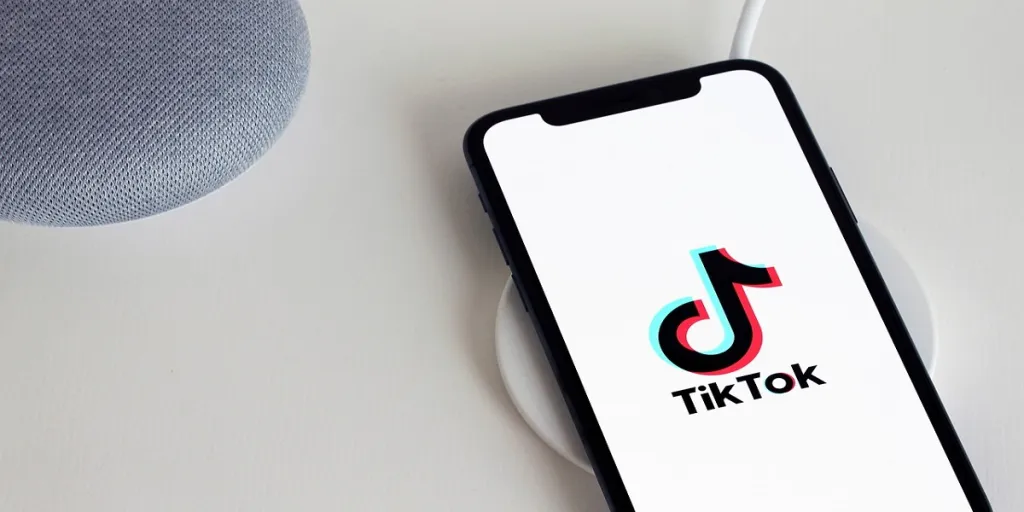




 Afrikaans
Afrikaans አማርኛ
አማርኛ العربية
العربية বাংলা
বাংলা Nederlands
Nederlands English
English Français
Français Deutsch
Deutsch हिन्दी
हिन्दी Bahasa Indonesia
Bahasa Indonesia Italiano
Italiano 日本語
日本語 한국어
한국어 Bahasa Melayu
Bahasa Melayu മലയാളം
മലയാളം پښتو
پښتو فارسی
فارسی Polski
Polski Português
Português Русский
Русский Español
Español Kiswahili
Kiswahili ไทย
ไทย Türkçe
Türkçe اردو
اردو Tiếng Việt
Tiếng Việt isiXhosa
isiXhosa Zulu
Zulu